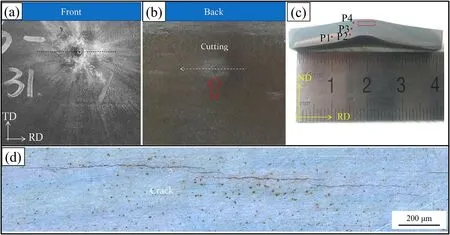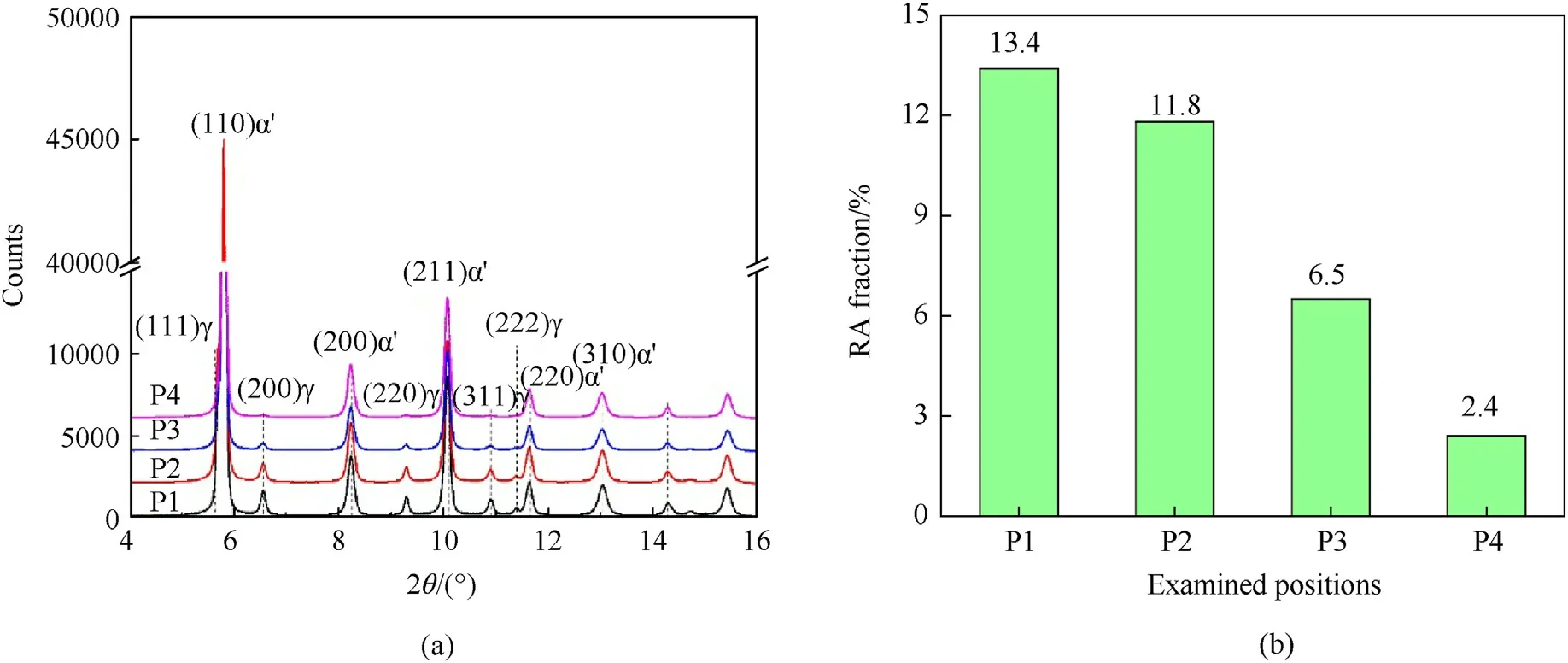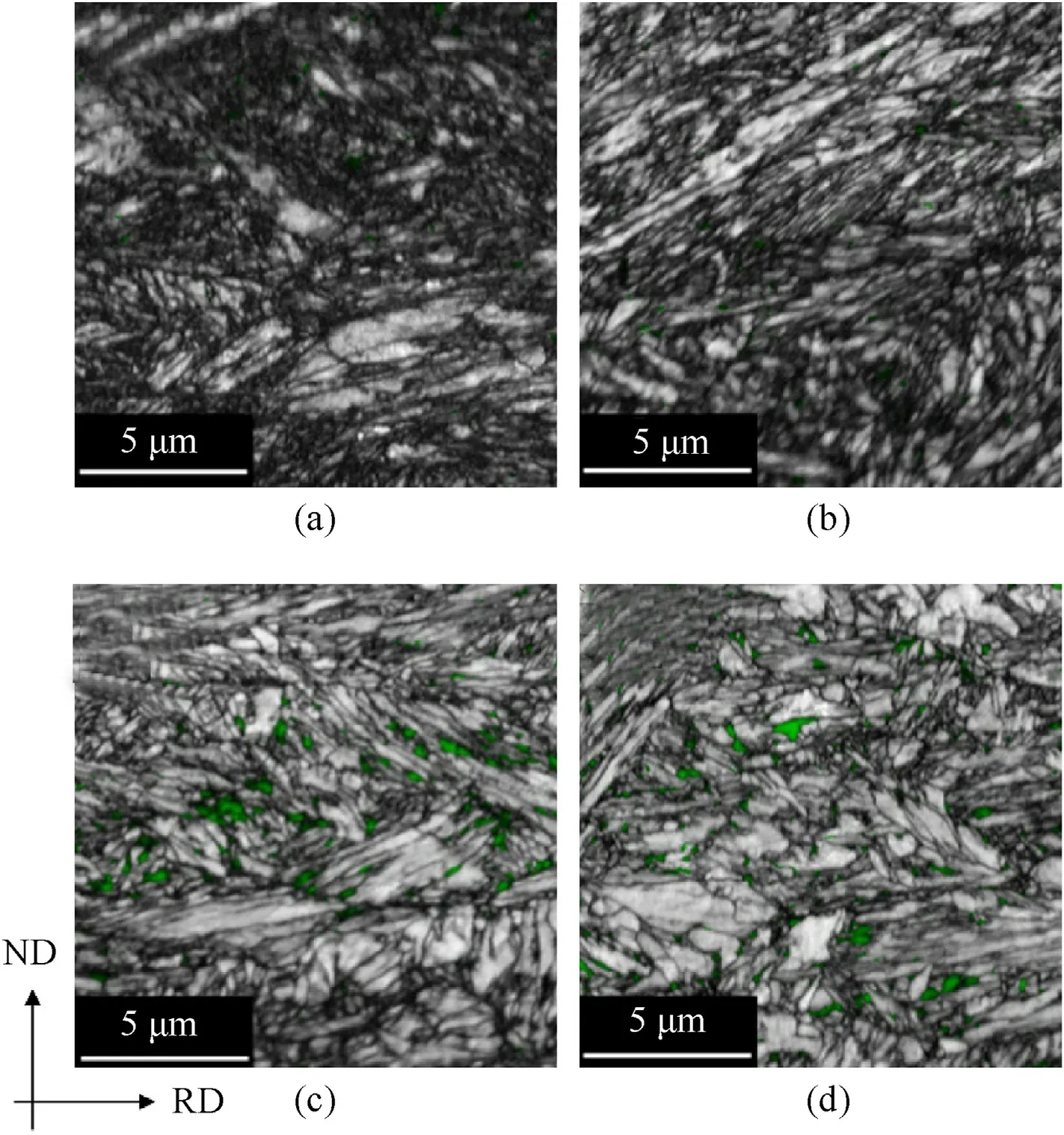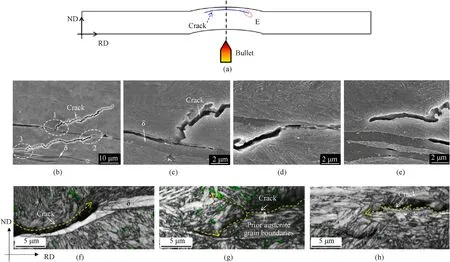Toughening ultrastrong low-density steel by textured δ-ferrite lamellas
Bin Hu , Guosen Zhu , Guohui Shen , Zheng Wng , Qinghu Wen , Xio Shen ,Hiwen Luo ,**
a School of Metallurgical and Ecological Engineering, University of Science and Technology Beijing, Xue Yuan Rd.30, Beijing 100083, China
b Shougang Research Institute of Technology, Yangzhuang Street 69, Beijing 100043, China
c Steel Institute, RWTH Aachen University, Intzestra?e 1, 52072, Aachen, Germany
Keywords:Ultrastrong and light steel δ-Ferrite lamellas Crack propagation Toughness
ABSTRACT By both the Charpy V-notched impact and the projectile tests,we here investigated the dynamic fracture behavior of a recently developed ultrastrong lightweight steel comprising a hierarchical martensitic matrix,dispersed ultra-fine-retained austenite grains and oriented δ-ferrite lamellas,the latter being due to high Al and Si contents employed for low-density design.This steel shows a superior combination of specific ultimate tensile strength and impact toughness to other ultrastrong steels and has successfully arrested a real steel-cored bullet shot.These are attributed to the densely textured δ-ferrite lamellas that can deflect the propagating cracks until they are trapped and enclosed besides austenite-to-martensite transformation crack closure, leading to more energy consumed before failure.These results suggest a new pathway for toughening ultrastrong lightweight steels.
1.Introduction
Ultrastrong but light steels have been long desired in the automotive, aviation, and defense industries to enhance engineering reliability and reduce CO2emissions[1].Unfortunately,both the popular strengthening solutions and lightweight designs often sacrifice toughness [2,3], the latter measures the capability of materials of resisting the cracking either dynamically or statically and is strictly required in the safety design.A classical high-end application example of ultrastrong steel is the armored vehicle because it requires both improved maneuverability and travelling speed via reduced density and excellent ballistic performance [4].The bulletproof properties could be improved by increasing both hardness/strength to suppress the plugging failure and toughness to avoid the brittle fracture during the ballistic test[5,6].
A general method of toughening ultrastrong steels is to increase the plastic energy consumed in the vicinity of the propagating crack that leads to the failure[7].Therefore,a metal that can resist higher load and plastically deform more during deformation is more tough in general[8].Recently,we have developed an ultrastrong tri-phase steel possessing an ultrahigh tensile strength (UTS) of 2112 MPa,total elongation(TE)of 16%at the reduced density of 7.39 g/cm3[9].In addition to its ultrahigh tensile strength and good ductility, it also exhibits the extraordinary plastic-hardening capacity of 1360 MPa, which may also improve the bulletproof performance,because high-N austenitic stainless steel,having a relative low yield strength (YS) and high work hardening rate, behaves similarly to ultrastrong martensitic armor steels during the projectile tests[10].Moreover, the microstructure of developed steel exhibited lamellated morphology [9], which is beneficial to improving the toughness at high strength and low density [11-14].As an example, the laminated ferrite was introduced into the martensite matrix,leading to the Charpy V-notch toughness increasing by 10 times that of the conventional low alloy steels with the similar strength[14].Therefore,such an excellent combination of tensile properties and lamellated microstructure may hint a possibly excellent toughness and then bulletproof performance too, making this ultrastrong steel ideally fit the application of armored vehicle.In this paper, both the standard Charpy V-notched (CVN)impact and ballistic tests were performed on this ultrastrong steel to examine its resistance to dynamic fracture;particularly,the cracking path in the tri-phase microstructure was traced carefully during the impact and projectile tests, leading to a new finding that a considerable amount of relatively soft and properly textured δ-ferrite lamellas could toughen rather than embrittle this ultrastrong steel by increasing the energy required to rupture it.Finally, we propose a new low-density microstructural design strategy for toughening ultrastrong steels and enhancing bulletproof capability.
2.Experimental methods
The studied steel plate was hot rolled and tempered, having a 4.9-mm thickness and the nominal composition of 0.38% C-6.74%Mn-1.27% Si-2.91% Al-0.38% V-0.034% Nb-0.0029% B (weight percentage unless mentioned elsewhere).It has a measured density of 7.36 ± 0.03 g/cm3by using the Archemedes principle and hardness of 62 HRC.The YS (σ0.2), UTS, TE along the rolling and transverse directions (RD and TD) were measured as 1300 MPa,2105 MPa,16% and 1306 MPa, 2122 MPa,13% respectively.Details on the compositional designing strategy and manufacturing process have been described elsewhere [9].CVN impact tests were performed at -40°C according to ASTM A370 on the V-notched specimens with the dimension of 55 mm (length) × 10 mm(width)×4.9 mm(thickness).The CVN specimens were grooved on the ND (normal direction) × RD plane.The ballistic tests were conducted at zero obliquity, i.e.the projectile path was normal to the plane of the target plate.During the bulletproof tests,steel plate with the 407 mm×135 mm size was clamped firmly to the target holder already positioned for an attack angle of 90°.The steel-cored projectiles with the diameter of 7.62 mm were fired with the muzzle velocity of 825-827 m/s from a gun at the distance of 80 m.According to the military standards on the ballistic tests,the centerto-center distance between any two impact craters on the plate must be at least four times as the diameter of the projectile,while the distance from the impact center to the edge of the plate must be at least twice as the projectile diameter.Wherever these distance criteria were not met, the craters were not considered for further analysis.
The microstructures were examined by field emission scanning electron microscope (FE-SEM),JSM-6710F,at 20 kV after polishing and etching in 4% nitric acid for 20 s.Electron backscattered diffraction (EBSD) examination was performed on an Auger Nano probe combined with EBSD (Nano-Auger/EBSD PHI 710) at 20 kV.The data were processed by EDAX OIM software.High-energy synchrotron X-ray diffraction (HEXRD) was employed to investigate the volume fraction of retained austenite (RA) around caters after ballistic test.The HEXRD experiments were conducted at the Powder Diffraction and Total Scattering Beamline P02.1 of PETRA III at Deutsches Elektronen Synchrotron (DESY) in Hamburg, Germany.The beamline was operated at a fixed energy of 60 keV,supplying a monochromatic X-ray with a wavelength of ~0.207 ?.RA fractions were calculated from the integrated intensities of(200)α, (211)α, (200)γ, (220)γ and (311)γ diffraction peaks, as detailed in Ref.[15].Samples for EBSD and XRD examinations were electro-polished in a solution of 20% perchloric acid and 80%ethanol at room temperature.
3.Results
3.1.CVN impact tests
The V-notched impact toughness of studied steel along the transverse and longitudinal directions at-40°C were measured as the 30 ± 2 J/cm2and 26.7 J/cm2respectively, which has been converted for being compared with the standard impact toughness values according to the proposed method in ‘Ship Specifications’[16].In Fig.1,both CVN toughness and specific UTS of studied steel are compared with other steels having the UTS of 1.0-2.5 GPa[17-29].It is seen that our developed steel has the superior combination of specific UTS and CVN toughness to any existing ultrastrong steel to date,to our knowledge.
SEM and EBSD results in Figs.2(a)and 2(b)show that the initial microstructures have a martensitic (α′) matrix, where both ultrafine RA grains,and elongated δ-ferrite lamellas with a strong{200}in-plane texture parallel to the sheet surface (Fig.2(c)) are dispersed.The δ-ferrite started to form during solidification due to the high Si and Al contents and was elongated to form a texture during hot rolling.The average diameters of prior austenite and RA grains were measured as 32 ± 6 μm and 0.73 ± 0.4 μm; while the length and thickness of δ-ferrite grains are 150-500 μm and 1-4 μm respectively.Figs.2(d) and 2(e) are the morphologies of fracture surfaces and the cracking path after the V-notched impact test.Martensitic matrix and δ-ferrite lamellas were fractured to form dimples and deep valleys respectively on the fracture surface(see Fig.2(d)),indicating a ductile fracture[31].Moreover,Fig.2(d)shows that the δ-ferrite lamellas on the deep valleys should have capture some propagating cracks and even deflect some of them,leading to rougher fracture surface formed.On the cross section below the surface fracture, delaminated cracks propagated along both prior austenite grain boundaries(PAGBs)and the interfaces of aligned δ-ferrite lamellas and martensite; both cracking paths are perpendicular to the striking direction(see Fig.2(e))but parallel to RD.The distance of cracks propagating along the PAGBs and the δferrite into the matrix was approximately 125 μm and 35 μm,respectively.This suggests that the δ-ferrite has a higher resistance to the propagation of cracking during the impact tests.Therefore,the deflection of delaminated cracks,either into elongated δ-ferrite or along the interface of δ-ferrite/martensite, could significantly improve impact toughness when compared with the mere propagation along the PAGBs.This results in higher CVN toughness achieved even at ultrahigh strength and low density than other ultrastrong steels.

Fig.1.Specific ultimate tensile strength and impact toughness of studied steel compared with other ultrastrong steels, including high strength low alloyed martensitic steels [17,18], maraging steel [19], stainless steels [20,21], armor steels[22,23], wear-resistant steels [24], lightweight steels [25,26], QP steels [27,28], nanobainite steels [29].The ‘11 mm-thick steel’ is the present studied steel having the thickness of 11 mm after a different hot rolling process,from which the standard CVN specimen having the dimension of 10 mm × 10 mm × 55 mm was machined for measuring impact toughness.The densities were calculated by the method proposed in Ref.[30] from their compositions when they were not given in the references.

Fig.2.(a)Optical microscopy;(b),(c)EBSD and(d),(e)SEM results on the microstructures of studied steel before((a)-(c))and after((d)-(e))the CVN impact test,examined at the positions indicated by the arrows in the sketch map.(a)Tri-phase microstructures comprising martensitic matrix and oriented δ-ferrite lamellas and dispersed RA grains as revealed by the green in(b),EBSD band contrast image overlapped by phase distribution;(c)the corresponding inverse pole figure of(b);(d)the typical fracture surface morphology and the cracking paths below the surface (e).ND, RD and TD represent the normal, rolling and transverse directions.
3.2.Bulletproof tests
The front and back views of crater on the target steel sheet are shown in Figs.3(a) and 3(b).Neither penetration nor any visible cracking was observed on the impacted steel, indicating the shooting of bullet was successfully defended.Successful arrest was also indicated by the apparent plastic deformation near the crater.Although adiabatic shear bands often appear in the severely plastically deformed zone during the ballistic tests[32],they were not observed in this case most probably because this steel has high hardness and exceptional work hardening ability [33-35].The cross-sectional view below the crater in Figs.3(c) and 3(d) reveal some inner cracks, which propagated over several millimeters mostly perpendicularly to the striking direction and parallel to RD.
RA fractions were examined near the crater at the positions marked by P1, P2, P3, P4 in Fig.3(c) by using ex-situ high energy XRD.The obtained spectra are shown in Fig.4(a)and the calculated RA fractions in Fig.4(b).The latter gradually increase when the examined positions have larger distance to the back surface center of crater as they suffered smaller plastic strain.The microstructures at the positions of P4,P3,P2,P1 near the crater were also examined by EBSD and the results are show in Fig.5(a)through Fig.5(d).It is apparent that fewer RA grains survived at the position closer to the back surface center of crater,which is consistent with the HE-XRD results in Figs.3(a)and 3(b).This is clearly because more plastically strained RA grains are more likely to transform to martensite.
Fig.6 shows some cracks observed on the RD⊥ND section around the crater after the ballistic test.Figs.6(b)-6(e) and Figs.6(f)-6(h) are the SEM and EBSD results respectively showing the propagating path of primary crack starting from‘E’in Fig.6(a).These cracks propagated both parallelly and perpendicularly to the striking direction of bullet (Fig.6(b)).The parallelly propagating cracks were blunted by δ-ferrite lamellas,which are perpendicular to the striking direction,by deflecting them into the perpendicular direction, followed by their propagation in δ-ferrite lamellas(Fig.6(c)) or along the δ/α′interface (Fig.6(d)) when the cracks encountered them.In addition, some parallel cracks stopped propagation inside martensite matrix, see Fig.6(e).

Fig.3.(a)The front and(b)back views of target steel strip around the crate;(c)The cutting views of target steel strip around the crater along the transverse direction,as indicated in (b); (d) The magnified views for regions marked by red rectangles in (c).

Fig.4.(a) High energy XRD spectra obtained at the positions of P1, P2, P3, P4 in Fig.3(c); (b) The calculated RA fractions.
It is seen in Figs.6(f)-6(h) that the perpendicular cracks propagated along prior austenite grain boundaries (PAGBs) and δ/α′interface,which is exactly same to the propagation of delaminated cracks during the CVN impact tests in Fig.2(e).Furthermore,it was observed that the perpendicular cracks stopped propagation at the δ/α′interface (see Figs.6(f) and 6(g)) or inside martensite matrix(see Figs.6(g) and 6(h)).Fewer RA grains were found near the propagating cracks than those far away from them (see Figs.6(f)and 6(g)),indicating that more RA grains transformed to martensite at the positions closer to cracks due to more severe plastic strain encountered, which increased the energy required for the propagation of cracks and contributed to improved ballistic performance too.
4.Discussion
The studied lightweight steel indeed exhibits both superior combination of CVN toughness and specific UTS and the desired excellent bulletproof performance that was first achieved at such a reduced density, as expected.The latter is firstly ascribed to ultrahigh UTS(2.1 GPa)and hardness(62 HRC)to resist the penetration of bullets and avoid the plugging failure and the prominent strain hardening increment of 1.4 GPa to disperse the impact force of the bullet, the latter is also indicated by the pronounced plastic strain developed near the carter(see Fig.3(c)).Moreover,the strain rate in the ballistic test is much higher than that in the quasistatic tensile test,leading to even greater strain hardening capability to resist the projectile impact via the release of internal stress, dislocation multiplication and γ-to-α′transformation as concluded in Ref.[9].Particularly,both the XRD results in Fig.4 and EBSD results in Fig.5 confirm that the strain-induced martensite transformation has indeed occurred during the projectile tests since fewer RA grains survived at the positions subjected to greater plastic strain.Particularly, this strain-induced martensite transformation promotes the closure of cracks due to the volume expansion accompanying the transformation, which is documented as transformation-induced crack closure (TICC) [36].In addition,some cracks stopped propagating inside martensite after a zigzag cracking path (Figs.6(g) and 6(h)), which is attributed to roughness-induced crack closure(RICC) [37].

Fig.5.EBSD band contrast images overlapped with phase distribution for the microstructures examined at the positions of (a) P4, (b) P3, (c) P2, (d) P1 in Fig.3(c).The green represents retained austenite.
More importantly,this implies a new toughening mechanism in addition to them,i.e.the cracks were deflected and trapped in the δlamellas that were extensively distributed in the tri-phase microstructure,leading to the kinetic energy of the bullet absorbed much more effectively since the tip of crack was blunt in the relatively soft δ ferrite,the brittle intergranular cracking was suppressed and the length of cracking path increased significantly, as demonstrated above.When the bullet impact-induced cracks were initiated at either the PAGB or δ/α′interface,they can propagate both parallelly and perpendicularly to the striking direction.The parallel cracks resulted in undesired quick through-thickness fracture.When cracks met the{200}in-plane textured δ-ferrite lamellas,they were then captured and deflected in the direction perpendicular to the striking one and started to propagate inner δ-ferrite (Fig.6(a)through Fig.6(c)) or along the δ/α′interface (Figs.6(d) through 6(g)).These propagating cracks were blunted by the soft δ-layers with more resistance to the cracking than those along the PAGB(see Fig.2(e)).This is because the {100} cleavage is the natural failure mode of many bcc crystals, including iron [38].For an example,δ-ferrite in medium-Mn steel was observed to fracture on the {100} planes during the tensile test [39].In this case, these deflected cracks had to propagate over a much longer distance along the{100}planes of textured δ-ferrite together with more RA grains nearby transformed than those along the striking direction,leading to more energy being consumed before failure.These textured δ ferrite lamellas should also deflect the primary propagating cracks from the striking direction to the one perpendicular to it during the CVN impact test, as confirmed by the deep valleys on the fracture surface (Fig.2(d)) and the appearance of delaminated cracks along δ/α′interface or within δ-ferrite (Fig.2(e)).
Since the formation of δ-ferrite results from the low-density design that is realized by adding high contents of Si and Al, one may expect that more textured δ-ferrite lamellas dispersed perpendicularly to the striking direction could capture and deflect the propagating cracks more frequently, which could further improve toughness of lightweight steel with lower density.
5.Conclusions
Contrary to the classical wisdom that the formation of δ-ferrite due to the alloying with high contents of Al and Si often deteriorates mechanical properties of steels [39-43], we conclude that the textured δ-ferrite lamellas in the studied steel can capture the propagating cracks and deflect them so that they propagate along the interface of elongated δ lamella and α′and even into the δ ferrite grains,where they are trapped.This greatly improves both impact fracture toughness and the bulletproof performance of ultrastrong low-density steel.When these δ lamellas are more densely distributed perpendicularly to the striking direction,it may be reasonably expected that the propagating cracks shall be captured, deflected, and trapped more frequently.This leads to greater crack delamination and dynamic energy consumption,suggesting a new microstructural design strategy for improving the toughness and ballistic performance of ultrastrong armor steel with low density.

Fig.6.Microstructures around the crater on the steel sheet after the projectile test: (a) Schematical cutting view around the crater; SEM images ((b), (c), (d), (e)) and EBSD band contrast images overlapped by phase distribution((f)(g),(h))on the microstructures at the‘E’of(a)both comprise the propagating cracks.(c),(d)and(e)are the magnified views of ‘1’, ‘2’ and ‘3’ circles in (b) respectively.The green in (f)-(h) represents austenite.
Author contributions
H.W.Luo supervised the study.B.Hu and H.W.Luo designed the study.B.Hu and G.H.Shen conducted the thermomechanical treatment, the mechanical tests, and the microstructure characterization.B.Hu and H.Luo wrote the paper.
Declaration of competing interest
The authors declare that they have no known competing financial interests or personal relationships that could have appeared to influence the work reported in this paper.
Acknowledgements
Haiwen Luo and Bin Hu acknowledge financial support from National Natural Science Foundation of China (Grant Nos.51831002, 51904028 and 52233018), China and Fundamental Research Funds for the Central Universities (Grant No.06500151),China.The present work is related to awarded patents(201910244716.9 in China and US 10793932 in USA).
- Defence Technology的其它文章
- Ground threat prediction-based path planning of unmanned autonomous helicopter using hybrid enhanced artificial bee colony algorithm
- Layered metastructure containing freely-designed local resonators for wave attenuation
- Predicting impact strength of perforated targets using artificial neural networks trained on FEM-generated datasets
- Construct a 3D microsphere of HMX/B/Al/PTFE to obtain the high energy and combustion reactivity
- Ignition processes and characteristics of charring conductive polymers with a cavity geometry in precombustion chamber for applications in micro/nano satellite hybrid rocket motors
- Recent research in mechanical properties of geopolymer-based ultrahigh-performance concrete: A review

